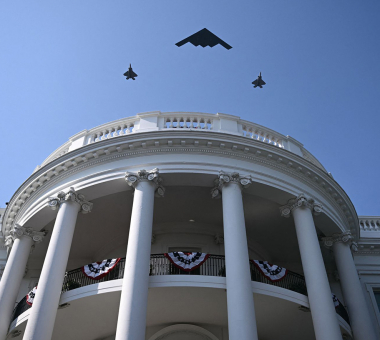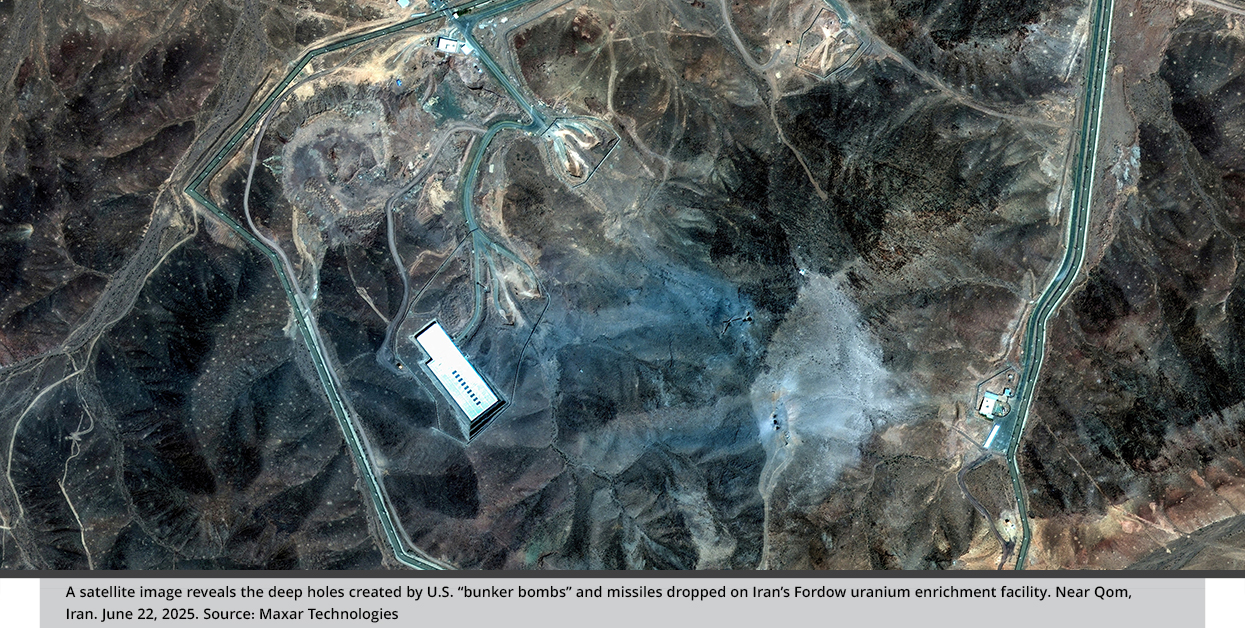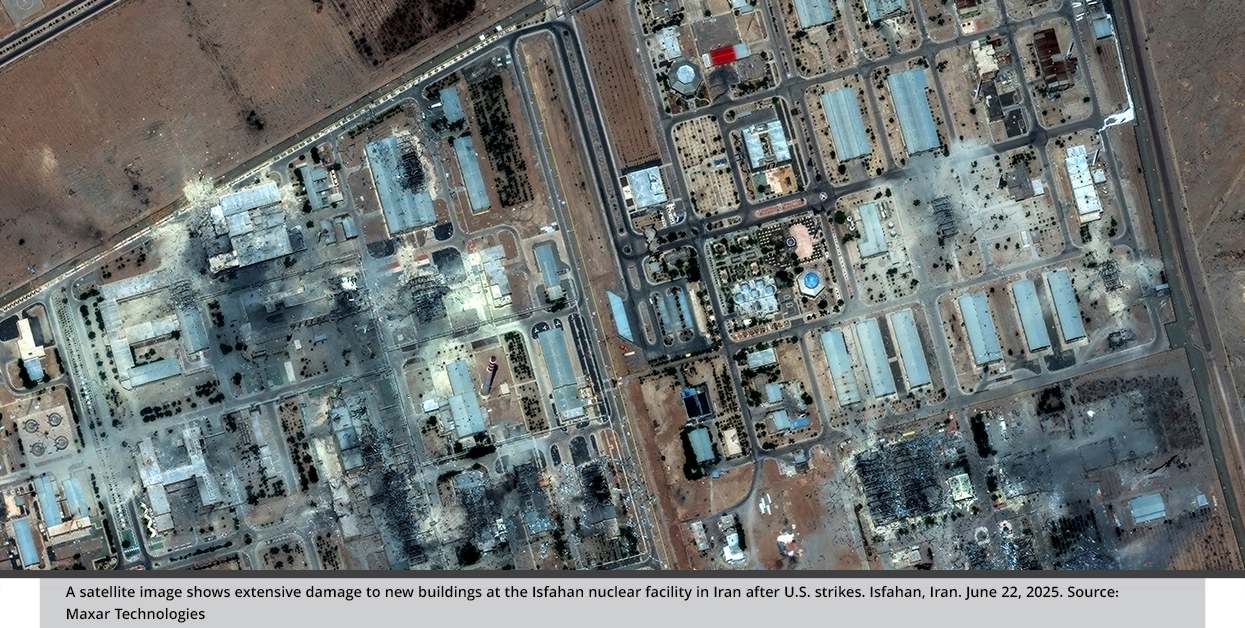How the B-2 Stealth Bomber Changed the Course of U.S.–Iran Negotiations
The U.S. airstrike on Iranian nuclear facilities in June 2025, carried out as part of “Operation Midnight Hammer,” marked a fundamental turning point in the trajectory of negotiations between Washington and Tehran. The United States shifted from a strategy of economic pressure and multilateral diplomacy to the direct use of military force, in unprecedented alignment with Israel’s approach. Today, Iran stands at a critical crossroads: either accept American-Israeli demands, or risk resuming its nuclear program and facing another wave of military escalation.
by STRATEGIECS Team
- Release Date – Jul 22, 2025

The U.S. strike of seven B-2 stealth bombers that flew 37 hours non-stop to drop 14 bunker-busting bombs on Iranian nuclear facilities marks a turning point in the nature of the Iranian nuclear file and in the negotiation, track pursued by both countries since 2011. The first shift occurred during the talks held between April and June 2025, in the context of the developments and repercussions of the war in the Gaza Strip. Any future negotiations are likely to witness a second, more explicit transformation—particularly in light of the outcomes of the June 2025 U.S. strike.
This goes beyond the traditional frameworks of negotiation in terms of form, nature, parties involved, objectives, and timeframe. It imposes new local and external priorities and choices on the key actors—namely Iran, the United States, and Israel—which intersect and overlap with each party’s vision of the Iranian nuclear file and its future.
The Moment of Intersection between the U.S.–Israeli Approaches
America’s “Operation Midnight Hammer” that targeted Iran’s three main nuclear facilities—Natanz, Isfahan, and Fordow—on June 22 marked a strategic turning point: the intersection between the American and Israeli approaches to addressing the Iranian nuclear file.
Previously, each country had followed its own tactical path, which were, at times, contradictory. Beginning in. in 2013, the United States emphasized a multilateral negotiation track that led to the 2015 nuclear deal, the 2021 Vienna peace talks, and the “semi-direct” negotiations of 2025.
Except for the recent rounds held between April and June, the negotiation framework had been largely asymmetric. The United States held the economic pressure card, offering sanctions relief—imposed on Iran since 2006—in exchange for Iran reducing its uranium enrichment levels, limiting the number of centrifuges, and allowing International Atomic Energy Agency (IAEA) inspectors access to its nuclear facilities. Iran, in turn, wielded a complex set of bargaining tools in addition to its ballistic missile program, including moderating the activities of its regional proxies and its destabilizing behavior.
In contrast, Israel opposed the negotiation track and the outcomes of the Joint Comprehensive Plan of Action (JCPOA) signed in 2015. It consistently played a disruptive role in the negotiations, especially after the first administration of U.S. President Donald Trump (2017–2021) withdrew from the agreement—a move Israel had openly welcomed.
Israel pursued its own strategy based on covert operations and intelligence work. In 2010, it was accused of orchestrating a cyberattack using “Stuxnet” malware that disabled thousands of centrifuges at the Natanz facility. In 2018, Israeli intelligence seized Iran’s nuclear archive—around half a ton of classified documents—from a fortified warehouse south of Tehran.
In July 2020, Israel was accused of causing explosions at the Natanz facility that damaged centrifuges. That same month, a wave of mysterious fires and explosions hit various industrial sites, including nuclear-related ones. In November of the same year, Israel was accused of a complex operation that assassinated Mohsen Fakhrizadeh, the nuclear physicist regarded as the chief of Iran’s nuclear program. Then in April 2021, another sabotage incident at the Natanz site—also blamed on Israel—damaged several advanced centrifuges.
This trajectory continued until Israel launched “Operation Rising Lion” on June 13, 2025, which directly targeted locations inside Iran—including scientific research centers, nuclear facilities, and military industries. The operation also destroyed a backup copy of Iran’s nuclear archive and assassinated some of its top nuclear scientists.
Cumulatively, and especially since the outbreak of the war in the Gaza Strip, this operation paved the way and created the regional conditions necessary for the U.S. to intervene and carry out “Operation Midnight Hammer.” This marked the moment when the American and Israeli approaches converged on a direct, forceful military response to Iran’s nuclear program—a goal long pursued by Israel and urged upon the U.S., which had until then remained committed to the negotiation track and even attempted to restrain Israeli action, given Israel’s limited logistical and strike capabilities to carry out deep attacks on Iran’s nuclear infrastructure.
This shift was neither temporary nor symbolic. It resulted in the actual use of hard power for the first time since the inception of Iran’s nuclear program. The outcome imposed ongoing American commitments to prevent Iran from returning to its pre-strike status or treating negotiations as the sole strategic option to contain its nuclear capabilities—especially given that the military action came with virtually no repercussions and proved decisive in halting the escalation between Israel and Iran.

The State of Negotiations After “Midnight Hammer”
Most previous U.S.–Iran multilateral negotiations—as well as Israel’s covert military operations—were primarily aimed at delaying or disrupting Iran’s nuclear development and freezing its enrichment activities.
Driven by the consequences and ripple effects of the ongoing war in Gaza war, that goal has now significantly expanded toward the complete dismantling of Iran’s nuclear program. The conflict In Gaza partially eroded Iran’s actual and negotiating leverage, inflicting major damage on its network of regional proxies, most notably Hezbollah in Lebanon. This led to the practical collapse of Iran’s “Unification of Arenas ” strategy and the fragmentation of the once powerful “Axis of Resistance.”
These developments after the Gaza war began in 2023 weakened Iran’s negotiating position well before the recent Israeli–U.S. military strikes. In this context, the five rounds of U.S.–Iran negotiations held this year between April and June stood out as an exception compared to previous rounds—on multiple levels.
Earlier negotiations were marked by several key characteristics: prolonged duration, the complexity of their phases, balanced bargaining power, multiple facilitating or mediating parties, and Iran’s refusal to make concessions beyond minor tactical adjustments to its nuclear program. Hence, the negotiations between Iran and the United Nation’s P5+1 group (China, the United States, France, the United Kingdom, Russia, and Germany) lasted nearly three years. It began in Istanbul in April 2012 and took 19 months for both sides to sign a preliminary agreement, the Joint Plan of Action, that imposed a temporary freeze on some of Iran’s nuclear activities in exchange for partial sanctions relief from the United States.
Negotiations then continued, culminating in Iran, the P5+1, and the European Union signing the JCPOA in 2015. Under this agreement, Iran agreed to reduce its number of centrifuges by two-thirds, cap its uranium enrichment level to 3.67%, and limit its stockpile of low-enriched uranium to 300 kilograms for 15 years. In return, its nuclear facilities would be subject to international monitoring for the next 15 years.
By contrast, the 2025 negotiation framework witnessed fundamental differences. One of the most notable was that the United States approached these talks as a unique opportunity to capitalize on Iran’s weakened position following the war, aiming not merely to delay or freeze Iran’s nuclear activities—as in past negotiations—but to impose stronger demands and extract strategic concessions. Moreover, Washington excluded traditional mediators, including European, Russian, and Chinese parties, and conducted the talks in a semi-direct format.
Most critically, a fixed timeline was set for producing tangible results. America gave Iran a 60-day deadline, after which Trump would move forward with the military option without waiting for the sixth round of talks scheduled for June 14.
This shift indicates that future negotiation rounds will be shaped by a new, central variable: the destruction of Iran’s main nuclear facilities and its loss of capacity to enrich or reprocess uranium—from the initial conversion into “yellowcake” to the production of enriched uranium metal. This means that even the nuclear assets that survived the U.S. strikes will, in practical terms, remain ineffective until the damaged parts of the facilities are rebuilt.
Iran’s Nuclear Program and the Options of Key Actors
The U.S. strike on Iran’s nuclear facilities inflicted severe damage, yet a deep divergence remains between military and intelligence assessments. The U.S. military claims that the Fordow facility was completely destroyed while many intelligence reports suggest, to varying degrees, that the damage may only disable the facilities for several months or, at most, a year or two. These reports also note Iran’s potential to eventually restore its infrastructure, equipment, and operational capacity.
Moreover, European, Israeli, and American estimates indicate that Iran currently possesses around 400 kilograms(about 881 pounds) of highly enriched uranium—a quantity large enough, according to experts, to be converted into a nuclear weapon, assuming the necessary technical knowledge and tools were available.
In reality, Iran’s nuclear program is far more complex than the nuclear efforts previously destroyed by the United States or Israel, such as Iraq’s and Syria’s programs, or Libya’s program that was dismantled. Iran’s program is advanced, heavily reliant on domestic expertise, and has been in development for more than three decades. It is also deeply embedded within the Iranian political system’s ideological framework and strategic doctrine.
This unique context makes it difficult to imagine a complete termination of the program or Tehran willingly abandoning efforts to restore and advance it. At the same time, it underscores why Iran’s nuclear program will remain a permanent item on the strategic agendas of Iran, Israel, and the United States.
Despite the destruction of key infrastructure and the likely loss of expert personnel, Iran still possesses the experience, determination, and capability it has demonstrated over the past decades. Given that delays in achieving their objectives may risk returning the United States and Israel to square one, these factors suggest it is highly likely that both the United States and Israel will push for rapid and decisive negotiations or, failing that, resort to further military action.

So far, it appears that the United States is inclined to give diplomacy a chance to translate the military outcomes—regardless of differing assessments—into more lasting political gains.
Iran, too, seems interested in this path, especially as military threats against it have become more credible and realistic. Additionally, Iran’s ability to manage any future covert nuclear activity appears increasingly constrained due to Israel’s extensive intelligence penetration that gave it prior knowledge of the locations where enriched uranium was stored after being moved from the Fordow facility before the U.S. strike.
This likelihood is further supported by Iranian Foreign Minister Abbas Araghchi’s July 8 statement affirming Iran’s interest in the diplomatic path—remarks that came shortly after Trump announced that Washington and Tehran were planning to hold discussions.
Nevertheless, the upcoming negotiation framework is likely to witness a new, fundamental shift, possibly even deeper than the one that occurred between April and June this year. In this context, two main scenarios can be reasonably anticipated.
- Advancing a negotiation track that goes beyond interim agreements or temporary understandings to achieve the comprehensive dismantling of Iran’s nuclear capabilities within its territory in exchange for partially recognizing Iran’s right to peaceful nuclear use—but only outside its borders.
This is precisely the outcome Israel is pushing for, particularly in the wake of the U.S. military strike in June. Israeli officials have emphasized that the negotiation process must lead to one outcome: the total and irreversible dismantling of Iran’s nuclear program, including the transfer of enriched uranium stockpiles to a third-party country under full international supervision.
- Freezing uranium enrichment activities in Iran at low levels, while allowing a limited peaceful-use capacity capped at 3.76% enrichment under expanded international monitoring.
This monitoring would involve stricter inspection mechanisms than those outlined in the 2015 agreement, including the appointment of a third-party supervisor to oversee Iran’s nuclear assets and ensure unconditional access to all relevant sites. This third party could be the IAEA, while a broader framework might allow for the resumption of operations at declared nuclear facilities—such as Natanz—under the management of a neutral state with advanced nuclear expertise, such as France or South Korea. Both countries maintain extensive nuclear cooperation with other states in the Middle East, making them viable candidates for a supervisory role.
Iran’s Two Options
In the aftermath of the U.S. strike, Iran now faces two primary options: either comply with the U.S.–Israeli conditions and demands or reject negotiations under those terms and resume the development of its nuclear capabilities—a move that would very likely trigger a renewed military response.
Tehran may find itself compelled to negotiate out of necessity, driven by military pressure rather than from a position of strength as in previous negotiation rounds. Fears over the domestic consequences of a wider conflict with Israel—particularly its impact on the regime’s legitimacy—combined with Iran’s deepening economic crisis are pushing Tehran toward accepting the likely terms of negotiation as a way to ease international pressure and avoid internal fragmentation and unrest.
On the other hand, the negotiation track may stall if Iran’s leadership insists on preserving its right to enrich uranium on its own soil, viewing it as a matter of sovereignty that cannot be compromised or outsourced—especially amid pressure from hardline factions that will fight against any demands by the United States or Israel.
If this scenario unfolds, it could ultimately lead to the collapse of the diplomatic track and a renewed activation of military and intelligence operations targeting Iran’s nuclear infrastructure in a final attempt to forcibly dismantle its program.

STRATEGIECS Team
Policy Analysis Team
 العربية
العربية